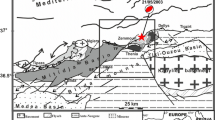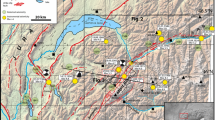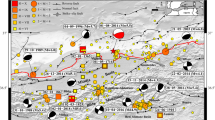Abstract
The El Mayor-Cucapah earthquake sequence started with a few foreshocks in March 2010, and a second sequence of 15 foreshocks of M > 2 (up to M4.4) that occurred during the 24 h preceding the mainshock. The foreshocks occurred along a north–south trend near the mainshock epicenter. The M w 7.2 mainshock on April 4 exhibited complex faulting, possibly starting with a ~M6 normal faulting event, followed ~15 s later by the main event, which included simultaneous normal and right-lateral strike-slip faulting. The aftershock zone extends for 120 km from the south end of the Elsinore fault zone north of the US–Mexico border almost to the northern tip of the Gulf of California. The waveform-relocated aftershocks form two abutting clusters, each about 50 km long, as well as a 10 km north–south aftershock zone just north of the epicenter of the mainshock. Even though the Baja California data are included, the magnitude of completeness and the hypocentral errors increase gradually with distance south of the international border. The spatial distribution of large aftershocks is asymmetric with five M5+ aftershocks located to the south of the mainshock, and only one M5.7 aftershock, but numerous smaller aftershocks to the north. Further, the northwest aftershock cluster exhibits complex faulting on both northwest and northeast planes. Thus, the aftershocks also express a complex pattern of stress release along strike. The overall rate of decay of the aftershocks is similar to the rate of decay of a generic California aftershock sequence. In addition, some triggered seismicity was recorded along the Elsinore and San Jacinto faults to the north, but significant northward migration of aftershocks has not occurred. The synthesis of the El Mayor-Cucapah sequence reveals transtensional regional tectonics, including the westward growth of the Mexicali Valley and the transfer of Pacific–North America plate motion from the Gulf of California in the south into the southernmost San Andreas fault system to the north. We propose that the location of the 2010 El Mayor-Cucapah, as well as the 1992 Landers and 1999 Hector Mine earthquakes, may have been controlled by the bends in the plate boundary.











Similar content being viewed by others
References
Abercrombie, R.E., Antolik, M., and Ekstrom, G. (2003), The June 2000 M w 7.9 earthquakes south of Sumatra: deformation in the India–Australia plate J. Geophys. Res., 108, B1, 2018. doi:2010.1029/2001JB000674.
Adamova, P., and Sileny, J. (2010), Non-double-couple earthquake mechanism as an artifact of the point-source approach applied to a finite-extent focus, Bull. Seismol. Soc. Am., 100, 447–457. doi:410.1785/0120090097.
Aragón-Arreola, M., and Martín-Barajas, A. (2007), Westward migration of extension in the northern Gulf of California, Mexico, Geology, v. 35, 571–574. doi:10.1130/G23360A.1.
Axen, G. J, Fletcher, J. M., Cowgill, E., Murphy, M., Kapp, P., Macmillan, I., Ramos-Velazquez, E., and Aranda-Gomez, J. (1999), Range-front fault scarps of the Sierra El Mayor, Baja California: formed above a low-angle normal fault? Geology, v. 27, 247–250.
Barnard, F. L. (1968), Structural geology of the Sierra de los Cucapahs, northeastern Baja California, Mexico, and Imperial County, California, Thesis, University of Colorado, Boulder, Colorado, 157p.
Bird, P. (2003), An updated digital model of plate boundaries, Geochem. Geophys. Geosyst., 4(3), 1027. doi:10.1029/2001GC000252.
Clinton, J. F., Hauksson, E., and Solanki, K. (2006), An evaluation of the SCSN moment tensor solutions: robustness of the M W magnitude scale, style of faulting, and automation of the method, Bull. Seismol. Soc. Am., 96(5). doi:10.1785/0120050241.
Dreger, D.S., and Helmberger, D. V. (1993), Determination of source parameters at regional distances with three-component sparse network data, J. Geophys. Res., 98, 8107–8125.
Elders, W.A., Rex, R.W., Meidav, T., Robinson, P.T., and Biehler, S. (1972), Crustal spreading in southern California, Science, 178, 15–24.
Fenby, S. S., and Gastil, R. G. (1991), Geologic-Tectonic map of the Gulf of California and surrounding areas, in, J. P. Dauphin and B. R. Simoneit, Eds., The Gulf and Peninsular Provinces of the Californias, AAPG Memoir 47, Tulsa, Oklahoma, p. 79–83.
Fialko, Y. (2006), Interseismic strain accumulation and the earthquake potential on the southern San Andreas fault system, Nature, v. 441. doi:10.1038/nature04797.
Fielding, E. J., LePrince, S., Wei, S., Sladen, A., Simons, M., Avouac, J.-P., Lohman, R., Briggs, R., Hudnut, K.,and Helmberger, D. (2010), InSAR and subpixel-correlation pixel-tracking measurements of the 2010 El Mayor-Cucapah earthquake, Geological Society of America, Cordilleran Section, Abstract LB2-1, Anaheim, California.
Fletcher, J. M., and Spelz, R. M. (2009), Pattterns of quaternary deformation and rupture propagation associated with an active low-angle normal fault, Laguna Salada, Mexico: evidence of a rolling hinge, Geosphere, v. 5, no. 4, 385–407. doi:10.1130/GES00206.1.
Fletcher, J., Rockwell, T. K., Teran, O., Masana, E., Faneros, G., Hudnut, K., Gonzalez, J., Gonzalez, A., Spelz, R., and Mueller, K. (2010), The surface ruptures associated with the El Mayor-Borrego earthquake sequence, Geological Society of America, Cordilleran section, Abstract LB1-5, Anaheim, California.
Glowacka, E., Vazquez Gonzalez, R., Sarychikhina, O. V., Nava Pichardo, F. A., Farfan Sanchez, F. J., and Diaz De Cossio Batani, G. E. (2010), Deformations triggered by the M = 7.2, April 4, 2010, El Mayor earthquake on faults in the Mexicali Valley. Geological Society of America, Cordilleran section, Abstract LB2-3, Anaheim, California.
González-Escobar, M., Aguilar-Campos, C., Suárez-Vidal, F., and Martín-Barajas, A. (2009), Geometry of the Wagner basin, upper Gulf of California based on seismic reflections, Int. Geol.Rev., v. 51, no. 2, p. 133–144.
González-Escobar, M., Suárez-Vidal, F., Hernández-Pérez, J. A., and Martín-Barajas, A. (2010), Seismic reflection-based evidence of a transfer zone between the Wagner and Consag basins: implications for defining the structural geometry of the northern Gulf of California, Geo-Marine Lett. doi:10.1007/s00367-010-0204-0, 10 pages.
Gurrola, L. D., and Rockwell T. K. (1996), Timing and slip for prehistoric earthquakes on the Superstition Mountain fault, Imperial Valley, southern California, J. Geophys. Res., v. 101, no. B3, 5977–5985.
Hauksson, E. (2000), Crustal structure and seismicity distributions adjacent to the Pacific-North America plate boundary in southern California, J. Geophys. Res., 105, 13,875–13,903.
Hauksson, E., Jones, L. M., Hutton, K., and Eberhart-Phillips, D. (1993), The 1992 Landers Earthquake Sequence: Seismological observations, J. Geophys. Res., 98, 19,835–19,858.
Hayes, G.P., Rivera, L., and Kanamori, H. (2009), Source Inversion of the W-Phase: real-time implementation and extension to low magnitudes, Seismol. Res. Lett., 80, 817–822.
Helmstetter, A., Quillon, G., and Sornette, D. (2003), Are aftershocks of large Californian earthquakes diffusing? J. Geophys. Res., v. 108, no. B10. doi:10.1029/2003JB002503.
Hough, S. E., and Elliott, A. (2004), Revisiting the February 23, 1892 Laguna Salada Earthquake, Bull. Seismol. Soc. Am., v. 94, no. 4, p. 1571–1578.
Hurtado-Artunduaga, A. D. (2002), Modelo estructural de la cuenca Wagner en el Golfo de California basado en sísmica de reflexión multicanal, M.S. Thesis, Universidad Nacional Autónoma de México, México, D. F., México. 93p.
Hutton, L. K., Woessner, J., and Hauksson, E. (2010), Seventy-seven years (1932–2009) of Earthquake Monitoring in Southern California, Bull. Seismol. Soc. Am., v. 100, no. 2, p. 423–446. doi:10.1785/0120090130.
Jennings, C.W. (1994), Fault activity map of California and adjacent areas: California Department of Conservation, Division of Mines and Geology, Geologic Data Map No. 6, scale 1:750,000.
Kanamori, H., and Rivera, L. (2008), Source inversion of W phase: speeding up seismic tsunami warning: Geophys. J. Int. 175, p. 222–238.
Kostrov, B.V. (1974), Seismic moment and energy of earthquakes, and seismic flow of rock, Izv. Acad. Sci. USSR Phys. Solid Earth, 1, 23–44.
Lay, T., Ammon, C.J., Kanamori, H., Rivera, L., Koper, K.D., and Hutko, A.R. (2010), The 2009 Samoa-Tonga great earthquake triggered doublet, Nature, Letter, 466, 964–968. doi:10.1038/nature09214.
Lin, J., and Stein R.S., (2004), Stress triggering in thrust and subduction earthquakes, and stress interaction between the southern San Andreas and nearby thrust and strike-slip faults, J. Geophys. Res., 109, B02303. doi:10.1029/2003JB002607.
Lomnitz, C., Mooser, C.R., Allen, C.R., Brune, J.N., and Thatcher, W. (1970), Seismicity and tectonics of the northern Gulf of California region, Mexico, Preliminary results, Geofis. Int. 10, 37–48.
Lundgren, P., Hetland, E. A., Liu, Z., and Fielding, E. J. (2009), Southern San Andreas–San Jacinto fault system slip rates estimated from earthquake cycle models constrained by GPS and interferometric synthetic aperture radar observations, J. Geophys. Res., v. 114, B02403. doi:10.1029/2008JB005996.
Magistrale, H., and Rockwell, T. K. (1996), The Central and Southern Elsinore Fault Zone, Southern California, Bull. Seismo. Soc. Am., v. 86, no. 6, pp. 1793–1803.
Mueller, K.J., and Rockwell, T.K. (1995), Late quaternary activity of the Laguna Salada fault in northern Baja California, Mexico. Geol. Soc. Am. Bull., v. 107, p. 8–18.
Munguía, L., Glowacka, E., Suárez,F., Sarychikhina, O., and Lira, H. (2009), Near-Fault Strong Ground Motions Recorded during the Morelia Normal-Fault Earthquakes of May 2006 in Mexicali Valley, B. C., México, Bull. Seismol. Soc. Am., v. 99, no. 3, 1538–1551.
Munguía, L., Navarro, M., Valdez, T., and Luna, M. (2010), Strong-motion data collected in Baja California during the El Mayor-Cucapah earthquake of April 4, 2010 (M w 7.2): Preliminary results, Geological Society of America Cordilleran Section, Abstract LB1-2, Anaheim, California.
Pacheco, M., Martín-Barajas, A., Elders, W., Espinosa-Cardena, J. M., Helenes, J., and Segura, A. (2006), Stratigraphy and structure of the Altar basin of NW Sonora: implications for the history of the Colorado River delta and the Salton Trough, Revista Mexicana de Ciencias, Geológicas, v. 23, no. 1, 1–22.
Reasenberg, P.A., and Jones, L.M. (1989), Earthquake hazard after a mainshock in California, Science 265, 1173–1176.
Sanders, C. O., and Kanamori, H. (1984), A seismotectonic analysis of the Anza Seismic Gap, San Jacinto Fault Zone, southern California, J. Geophys. Res., v. 89, 5873–5890.
Sandwell, D. T., Wei, M., Gonzales, J., Gonzales, A., Lipovski, B., Funning, G., Fialko, Y., Mellors, R., Agnew, D., and Peterson, R. (2010), InSAR and GPS measurements of crustal deformation from the El Mayor earthquake: liquefaction and triggered slip, Cordilleran section, Abstract LB1-8, Anaheim, California.
Sarychikhina, O., Glowacka, E., Mellors, R., Vázquez, R., Munguía, L. and Guzmán, M. (2009), Surface displacement and groundwater level changes associated with the May 24, 2006 M w 5.4 Morelia Fault Earthquake, Mexicali Valley, Baja California, Mexico. Bull. Seismol. Soc. Am. v. 99, no. 4, 2180–2189. doi:10.1785/0120080228.
Schmitt, A. K., and Vazquez, J. A. (2006), Alteration and remelting of nascent oceanic crust during continental rupture: evidence from zircon geochemistry of rhyolites and xenoliths from the Salton Trough, California, Earth plan. Sci. Lett., v. 252, p. 260–274. doi:10.1016/j.epsl.2006.09.41.
Suárez-Vidal, F., Mendoza-Borunda R., Nafarrete-Zamarripa L.M., Rámirez J., and Glowacka E. (2008), Shape and dimensions of the Cerro Prieto pull-apart basin, Mexicali, Baja California, Mexico, based on the regional seismic record and surface structures. Int. Geol. Rev., v. 50 (7), p. 636–649 (PA: 68049). doi:10.2747/0020-6814.50.7.636.
Suárez-Vidal, F., Mendoza-Borunda, R., Vazquez, S.,and Mendoza, L. (2010), Preliminary report of the geological effects and damage distribution of the April 4, 2010 Cucapah-El Mayor earthquake, Mexicali Valley, BC, Mexico, Geological Society of America, Cordilleran Section, Abstract LB2-2, Anaheim, California.
Suárez-Vidal, F., Munguía-Orozco, L., González-Escobar, M., González-García, J., and Glowacka, E. (2007), Surface rupture of the Morelia fault near the Cerro Prieto Geothermal field, Mexicali, Baja California, Mexico, during the M w 5.4 Earthquake of May 24, 2006, Seismol. Res. Lett., v. 78, no. 3, p. 394–399. doi:10.1785/gssrl.78.3.394.
Thurber, C. H. (1993), Local earthquake tomography: velocities and VP=VS-theory, in Seismic Tomography: Theory and Practice H. M. Iyer and K. Hirahara (Eds.), Chapman and Hall, London, pp 563–583.
Toda, S., Stein, R. S., Richards-Dinger, K., and Bozkurt, S. (2005), Forecasting the evolution of seismicity in southern California: animations built on earthquake stress transfer, J. Geophys. Res., B05S16. doi:10.1029/2004JB003415.
Treiman, J.A., Rymer, M.J., Kendrick, K.J., Lienkamper, J.J., Weldon, R.J. II, Hernandez, J.L., Irvine, P.J., Knepprath, N., Olson, B.P.E., and Sickler, R.R. (2010), Triggered slip in southern California as a result of the April 5, 2010 El Mayor-Cucapah earthquake, Geological Society of America, Cordilleran Section, Abstract LB2-5, Anaheim, California.
Waldhauser, F and Ellsworth W.L., (2000), A double-difference earthquake location algorithm: method and application to the northern Hayward Fault, California, Bull. Seismol. Soc. Am., 90, pp 1353–1368.
Wdowinski, S. (2009), Deep creep as a cause for the excess seismicity along the San Jacinto fault, Nat. Geosci., v. 2. doi:10.1038/NGEO684.
Wei, S., Sladen, A., LePrince, S., Avouac, J.-P., Fielding, E. J., Chu, R., Simons, M., Helmberger, D., Hauksson, E., and Lohman, R. (2010), Joint inversion of geodetic and seismic slip models for the April 4, 2010 El Mayor-Cucapah earthquake, Geological Society of America, Cordilleran Section, Abstract LB1-4, Anaheim, California.
Wessel, P., and Smith W. H. F. (1998). New version of the generic mapping tools released, EOS, 79, p.579.
Wiemer, S. (2001), A software package to analyze seismicity: ZMAP, Seismol. Res. Lett., 373–382.
Xu, Z., Shao, G., Ji, C., and Larson, K. (2010), Slip distribution of April 4, 2010 Baja California, Mexico earthquake constrained using teleseismic body and surface waves and high rate GPS, Geological Society of America, Cordilleran Section, Abstract LB1-7, Anaheim, California.
Acknowledgments
This research was supported by the US Geological Survey Grant G10AP00017; NSF grants EAR-0911761 and OCE-0742253 to Caltech, and by the Southern California Earthquake Center. SCEC is funded by NSF Cooperative Agreement EAR-0529922 and USGS Cooperative Agreement 07HQAG0008. The Incorporated Research Institutions for Seismology (IRIS) Data Management System (DMS) was used to access the Global Seismographic Network data. Funds for maintenance of RESNOM network are provided by CICESE. We thank S. Wei, S. Skinner, and E. Glowacka for feedback and discussions. We thank L. Munguía, G. Diaz, F. Farfan, I. Mendez, L. Orozco, O. Galvez, and S. Arregui, Department of Seismology, CICESE, Baja California, Mexico, and N. Scheckel, A. Guarino, and B. Wu of the SCSN for help with data collection and processing. Most figures were done using GMT (Wessel and Smith, 1998). SCEC contribution number 1,439. Contribution number 10,047, Seismological Laboratory, Division of Geological and Planetary Sciences, California Institute of Technology, Pasadena.
Author information
Authors and Affiliations
Corresponding author
Rights and permissions
About this article
Cite this article
Hauksson, E., Stock, J., Hutton, K. et al. The 2010 M w 7.2 El Mayor-Cucapah Earthquake Sequence, Baja California, Mexico and Southernmost California, USA: Active Seismotectonics along the Mexican Pacific Margin. Pure Appl. Geophys. 168, 1255–1277 (2011). https://doi.org/10.1007/s00024-010-0209-7
Received:
Revised:
Accepted:
Published:
Issue Date:
DOI: https://doi.org/10.1007/s00024-010-0209-7




